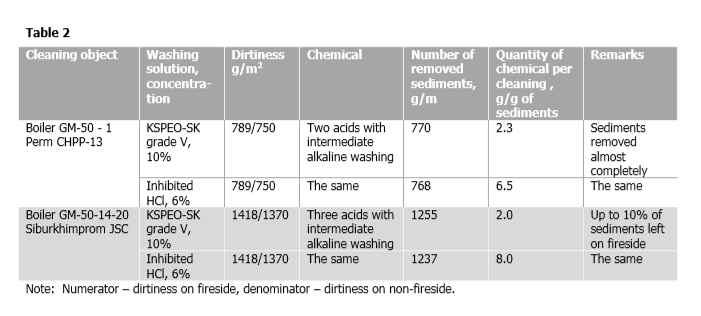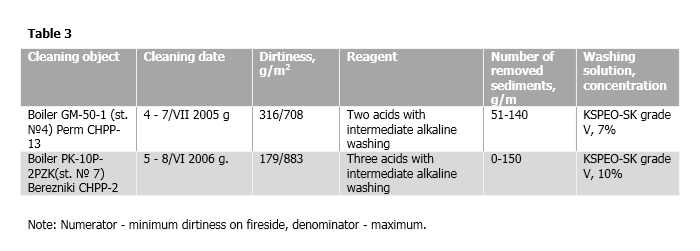L.I. Kudinova,
S.V. Karpova, engineers,
A.I. Mikov, PhD in Technical Science
A.I.Shishlov, PhD in Chemical Sciences
Operational chemical cleaning of boiler heating surfaces are performed to ensure the required purity of the inner surfaces of heating by removing of scale, sediments and corrosion formed during the operation process. Timely chemical cleaning is necessary to prevent accidents associated with overheating and rupture of metal tubes of boilers, as well as to improve heat transfer and reduce the rate of corrosion of the equipment during operation.
The main and the most effective method for removing of sediments from the inner surfaces of heating boilers is a chemical cleaning of boilers using strong mineral acids - hydrochloric, sulfuric, phosphoric, and others - with various additives [1,2]. Acids solutions combined with inhibiting additives and alkaline treatments can dissolve sediments of almost any composition. This property of cleaning solution is especially important for boilers of medium and low pressure, in which the most complex and diverse sediments form.
Use of inhibited hydrochloric acid solutions is the most popular for preoperational and operation cleaning of boilers due to low price and efficiency of sediments dissolving. Despite the widespread use, the technology with the use of liquid hydrochloric acid has a number of disadvantages. The most significant disadvantages are the transport problems associated with the delivery of significant amounts of highly reactive or corrosive reagent to the enterprises, the organization of special storage facilities for liquid chemical product. Rapid wear of equipment for loading and storing this reagent leads to the fact that a number of power plants waive chemical cleaning with use of hydrochloric acid and seek alternative methods for removing sediments from the internal surfaces of power equipment.
For the most part, the identified problems can be solved with use of highly concentrated dry acid compositions to clean the inner surfaces of heating boilers. Industry produces solid acids such as sulfamic, chloroacetic. However, these acids are highly hygroscopic, quickly cake show their aggressive acidic properties, even in initial solid condition.
Polyex jsc (Perm) developed inhibited dry acid solution KSPEO-SK and suggested to try it for chemical cleaning of power equipment. KSPEO-SK is a solid mixture bounded by inhibited nitric acid with special additives, which improve the basic properties of the chemical. When dry and solid the composition does not show the properties of acid, non-caking, fire-safe and therefore easy to transport and store. The composition contains specifically chosen inhibitor which effectively protects against corrosion. When dissolving the solution free nitric acid forms, other components of composition also go to the solution ensuring effective removal of sediments and friendliness to the process equipment.
The main physical and chemical characteristics of the dry commodity form of acid composition of KSPEO-SK grade V are given below
| Bulk density, kg/m3 | 600-800 |
|
The content of acids, in terms of 100% nitric acid, %, not less than |
40 |
|
Moisture content,%, not more than |
8 |
The main physical and chemical characteristics of 10% aqueous solution of acid composition of KSPEO-SK sort B are given below
| Density, kg/m3 | ~1025 |
| Viscosity, MPa | ~1.03 |
|
Moisture content,%, not more than |
|
|
The content of acids, in terms of 100% nitric acid, %, not less than |
4 |
|
Rate of dissolution (corrosion) of steel St-3 at 20° C, g/(m2h), not more than |
0.45 |
|
pH |
0.9-1.1 |
KSPEO-SK composition is produced in several grades for different applications and it is produced in the form of crystals white to gray in color, freely soluble in water.
The corrosion rate was determined by Polyex jsc with weight method. Appropriately prepared samples were fully-submerged in KSPEO-SK 10% aqueous solution by basic substance and incubated for 24 hours at 20° C. Average corrosiveness for steel boiler was 0.35 - 0.45 g / (m2-h).
Assessment of detergency of solutions of reagents was carried out on samples of furnace tubes in conditions simulating chemical cleaning. In parallel with, for comparison the sediments from the same sample were removed by inhibited hydrochloric acid.
The structure and composition of sediments on the presented pieces of furnace tubes of boilers GM-50-14-20 and GM-50-1 are typical for boilers of low and medium pressure. The chemical composition and amount of sediments on the test samples are shown in Table 1.

Laboratory wash was conducted in parallel on two samples of one tube with different washing solutions: 10% solution of KSPEO-SK grade V and 6% solution of inhibited hydrochloric acid. Temperature of washing solutions was 60° C. The results are shown in Table 2.

It was found that solutions of KSPEO-SK had a satisfactory cleaning power that is competitive to solution of inhibited hydrochloric acid. Consumption of dry acid composition KSPEO-SK is 3 - 4 times less than the consumption of hydrochloric acid (for commodities). Laboratory data obtained are in good agreement with theoretical calculations and show that the main component of the composition - nitric acid –similarly to hydrochloric acid, is a versatile chemical and is able to dissolve the typical deposits, including mixed-type formed at boilers operation. [3].
In view of the laboratory data on washing the furnace tubes, test chemical cleanings were planned and conducted at Perm CHPP-13 (boiler GM-50 st. N4) and Berezniki CHPP-2 (boiler PK-10 st. N7). Results of these chemical cleanings are given in Table 3 and should be regarded as satisfactory. Chemical KSPEO-SK warrants its purpose, is easy to use, cost effective and has a good ability to dissolve boiler scales.

Thus, Chemical KSPEO-SK can be used for chemical cleaning of boilers instead of inhibited hydrochloric acid and has a number of advantages compared with it:
transportability of the chemical to the consumer. The packed product is transported in any kind of covered road or rail cargo transport;
no special schemes of unloading, storage and preparation are required. The chemical is stored in container of manufacturer in covered storage spaces which prevent ingress of moisture. Standard and typical scheme of equipment for chemical cleanings is used to prepare the solution;
corrosion inhibitors and stimulators of decontamination contained in the chemical simplify the process of making washing solutions;
low rate of metal corrosion in KSCPEO-SK solutions.
List of references:
1. RD 34.37.402-96. Standard manual for operational chemical cleaning of boilers.
2. Chemical cleaning of thermal power equipment. Moscow: Energiya, 1978, ed. 2.
3. Handbook of chemical. Chemical equilibrium and kinetics, properties of solutions, electrode processes, 3, Moscow: Khimiya, 1965.
